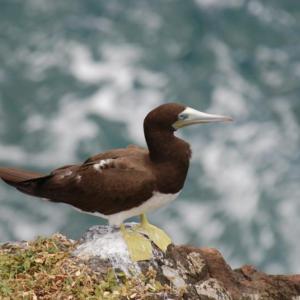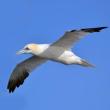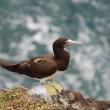What are These Boobies Doing in Maine?
 Northern gannets occur regularly in the Gulf of Maine. Courtesy of Andrew C, CC BY 2.0 , via Wikimedia Commons
Northern gannets occur regularly in the Gulf of Maine. Courtesy of Andrew C, CC BY 2.0 , via Wikimedia Commons
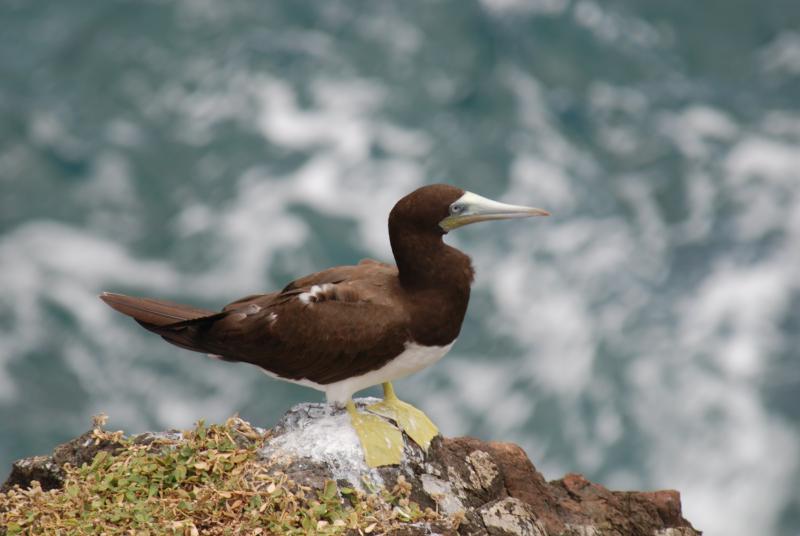 The brown booby, a tropical relative of the northern gannet, has been recorded in Maine at least seven times since the first record in 2011. Courtesy of The Lilac Breasted Roller, CC BY 2.0, via Wikimedia Commons
The brown booby, a tropical relative of the northern gannet, has been recorded in Maine at least seven times since the first record in 2011. Courtesy of The Lilac Breasted Roller, CC BY 2.0, via Wikimedia Commons
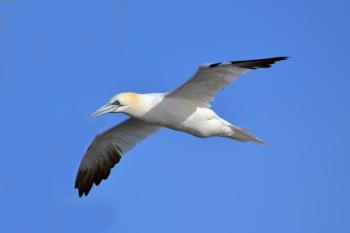 Northern gannets occur regularly in the Gulf of Maine. Courtesy of Andrew C, CC BY 2.0 , via Wikimedia Commons
Northern gannets occur regularly in the Gulf of Maine. Courtesy of Andrew C, CC BY 2.0 , via Wikimedia Commons
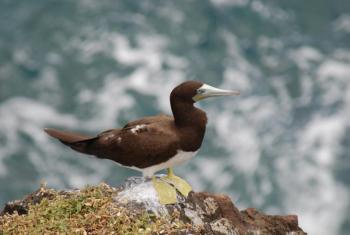 The brown booby, a tropical relative of the northern gannet, has been recorded in Maine at least seven times since the first record in 2011. Courtesy of The Lilac Breasted Roller, CC BY 2.0, via Wikimedia Commons
The brown booby, a tropical relative of the northern gannet, has been recorded in Maine at least seven times since the first record in 2011. Courtesy of The Lilac Breasted Roller, CC BY 2.0, via Wikimedia Commons
Many of you probably have seen or know of the bird called the northern gannet. Just last week we were at Pemaquid Point watching dozens of the massive birds skim over the ocean. Gannets are large, long-winged birds that spend their entire lives at sea except when, as adults, they tend to their single egg on an offshore island. Adults are a striking pure white except for jet black wingtips and a yellow cast to the head; immatures sport brown mottling, the extent of which lessens over the four to five years it takes to reach breeding age. In flight, because of its large bill and wedge-shaped ail, a gannet looks pointed at both ends.
One of the most spectacular things that gannets do is to dive straight down into the sea from 50 or more feet in the air. Their plunge takes them straight into a school of fish, with the goal of catching one. To see a bird of that size rocket down from the sky, like a spear into the ocean, is a sight that you will never forget.
Northern gannets occur regularly in Maine’s offshore waters, but in North America they nest only as far south as the Gulf of St. Lawrence and Newfoundland. Gannets are members of the Sulidae bird family, along with birds called boobies. Boobies, unlike gannets, inhabit tropical oceans. We have been fortunate to see red-footed, masked, and brown boobies in the Caribbean on a number of occasions. Masked and red-footed boobies are typically only seen far at sea. Brown boobies are the most widespread of the Caribbean boobies and are seen regularly from shore in places like Aruba, Bonaire, and Curaçao and from the islands of the Greater and Lesser Antilles.
The first record of brown booby here in Maine did not occur until 2011. Since that time, there have been at least six records of this warm water species. Maine can add at least one more record this year, as one was spotted roosting on the roof top of a shed on Great Duck Island, off Mt. Dessert Island, in late July and then on and around Mt. Desert Rock in August.
Even more startling was the first-ever sighting of a masked booby in Maine waters. This one was also spotted and photographed from Mt. Desert Rock in early August. (In case you’re wondering, no, there is no chance that these were the same bird, in a case of misidentification. We saw the photos and they are decisive!) Other than one other rare sighting of an individual hundreds of miles off the coast of New Jersey from a research vessel, there were no other sightings of masked booby reported to eBird during July and August north of Puerto Rico!
What brings birds like boobies to Maine? During the birds’ visit, there were no obvious hurricanes or tropical storms that could be blamed for bringing these birds to the Gulf of Maine. Given the more regular occurrence of brown boobies on the Maine coast, one has to wonder if the warming ocean is allowing these tropical birds to find food farther and farther north.
Next time you see a gannet, there’s no harm in taking a closer look to make sure you’re not seeing one of its warm water cousins.
Jeffrey V. Wells, Ph.D., is a Fellow of the Cornell Lab of Ornithology and Vice President of Boreal Conservation for National Audubon. Dr. Wells is one of the nation's leading bird experts and conservation biologists and author of the “Birder’s Conservation Handbook.” His grandfather, the late John Chase, was a columnist for the Boothbay Register for many years. Allison Childs Wells, formerly of the Cornell Lab of Ornithology, is a senior director at the Natural Resources Council of Maine, a nonprofit membership organization working statewide to protect the nature of Maine. Both are widely published natural history writers and are the authors of the popular books, “Maine’s Favorite Birds” (Tilbury House) and “Birds of Aruba, Bonaire, and Curaçao: A Site and Field Guide,” (Cornell University Press).
Event Date
Address
United States


